Search Result
Results for "
laser
" in MedChemExpress (MCE) Product Catalog:
3
Biochemical Assay Reagents
4
Isotope-Labeled Compounds
| Cat. No. |
Product Name |
Target |
Research Areas |
Chemical Structure |
-
- HY-121930
-
-
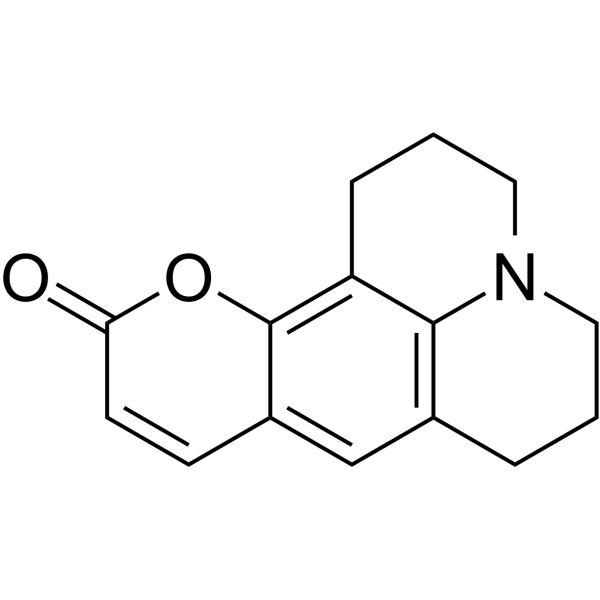
-
- HY-W248115
-
|
|
Fluorescent Dye
|
Others
|
|
Pyrromethene 597 is a BODIPY laser dye. Pyrromethene 597 displays wide tuning range of lasing wavelengths and high photostability. Pyrromethene 597 can be used as a thermal probe .
|
-

-
- HY-W180804
-
|
Coumarin 521
|
Others
|
Others
|
|
Coumarin 334 (Coumarin 521) is a laser dye with rigid structure .
|
-

-
- HY-W267393
-
|
|
Fluorescent Dye
|
Others
|
|
4,6-Dimethyl-7-ethylaminocoumarin is a laser dye for pulse and continuous operation .
|
-

-
- HY-D1174
-
|
|
Fluorescent Dye
|
Others
|
|
Rhodamine 700, a Lambdachrome laser dye, is one of the few rhodamine dyes with near infrared fluorescence. Rhodamine 700 can be used for mitochondrial staining .
|
-

-
- HY-136886
-
IR-820
1 Publications Verification
New Indocyanine Green
|
Fluorescent Dye
|
Cancer
|
|
IR-820 (New Indocyanine Green) is an infrared blood pool contrast agent. IR-820 also is normally used as a laser and near-infrared dye to detect and quantify diseased tissue in live animals .
|
-
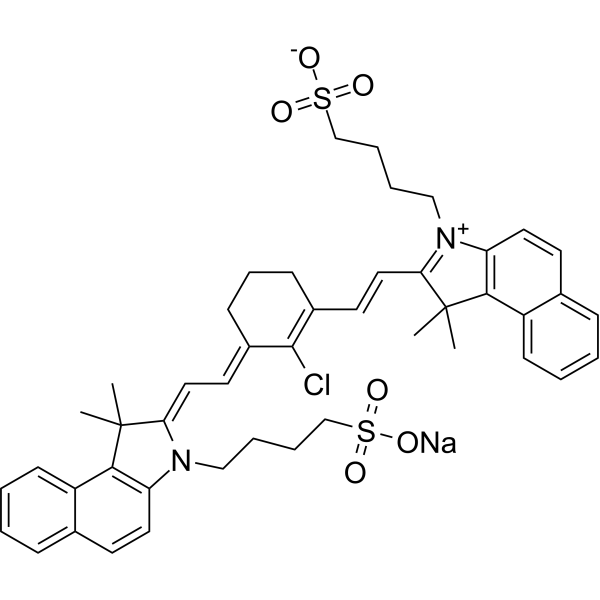
-
- HY-D0027
-
|
Coumarin 120; AMC
|
Fluorescent Dye
Antibiotic
Fungal
|
Infection
|
|
7-Amino-4-methylcoumarin belongs to a group of coumarins. 7-Amino-4-methylcoumarin can be isolated from an endophytic fungus Xylaria sp., has broad antimicrobial activity. 7-Amino-4-methylcoumarin is additionally commonly used as an important laser dye emitting in the blue region, as well as a fluorescent probe enabling analyses of glycoproteins’ monosaccharides and N-linked oligosaccharides. The excitation wavelength and emission wavelength are 351 nm and 430 nm, respectively .
|
-
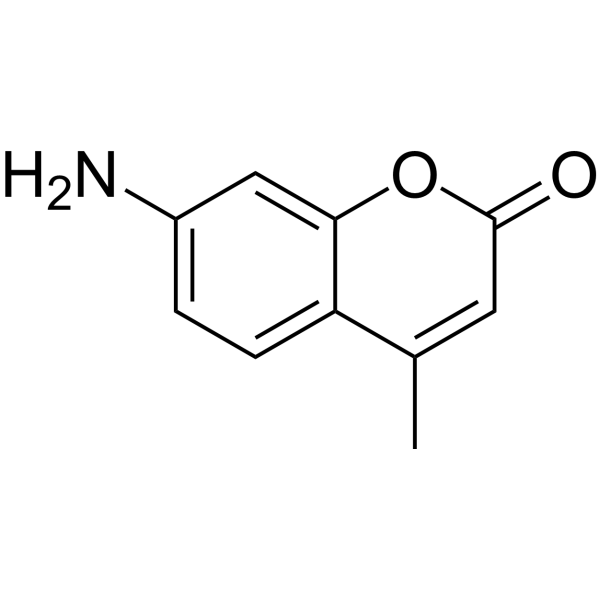
-
- HY-D0850
-
|
Sodium tartrate dibasic dihydrate; Sodium tartrate dihydrate
|
Phosphatase
Endogenous Metabolite
|
Cardiovascular Disease
|
|
Tartaric acid disodium dehydrate (L-(+) -tartaric acid) is an orally active weak organic acid that can be isolated from grapes. Tartaric acid disodium dehydrate has vasodilatory and antihypertensive effects. Tartaric acid disodium dehydrate can be used as flavorings and antioxidants in a range of foods and beverages. Tartaric acid disodium dehydrate can be used in laser frequency doubling and optical limiting applications .
|
-

-
- HY-W109973
-
|
L-(+)-Tartaric acid diammonium
|
Endogenous Metabolite
|
Cardiovascular Disease
|
|
L-Tartaric acid diammonium (L-(+) -tartaric acid) is an orally active weak organic acid that can be isolated from grapes. L-Tartaric acid diammonium has vasodilatory and antihypertensive effects. L-Tartaric acid diammonium can be used as flavorings and antioxidants in a range of foods and beverages. L-Tartaric acid diammonium can be used in laser frequency doubling and optical limiting applications .
|
-

-
- HY-D1762
-
-
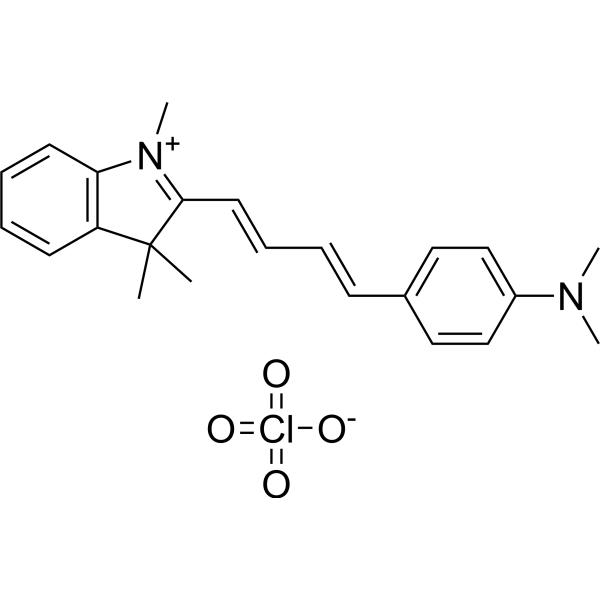
-
- HY-D1747
-
-
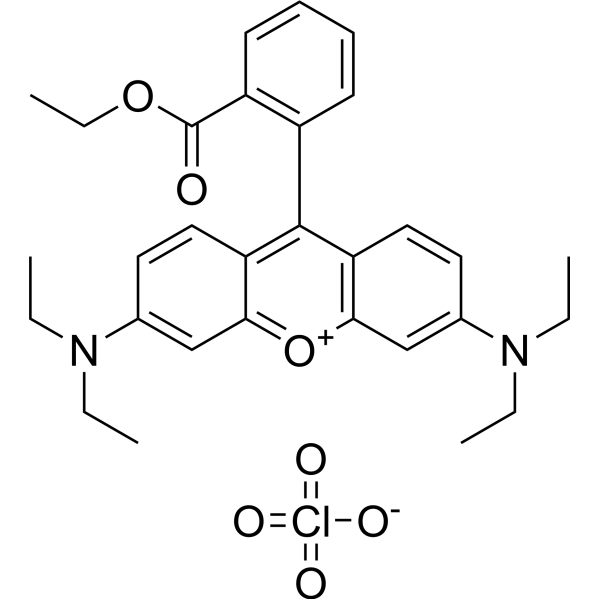
-
- HY-W268197
-
|
Coumarin 102
|
Others
|
Others
|
|
Coumarin 480 (Coumarin 102) is a laser dye .
|
-
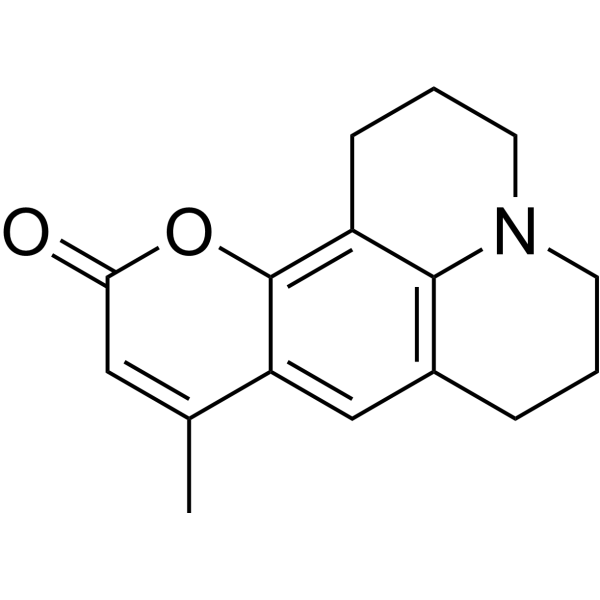
-
- HY-W440303
-
|
HITC
|
Fluorescent Dye
|
Others
|
|
1,1',3,3,3',3'-Hexamethylindotricarbocyanine perchlorate (HITC) is a long-wavelength, membrane-potential sensitive dye. It is a slow-response potentiometric fluorophore and has also been used as a laser dye for infrared lasers.
|
-
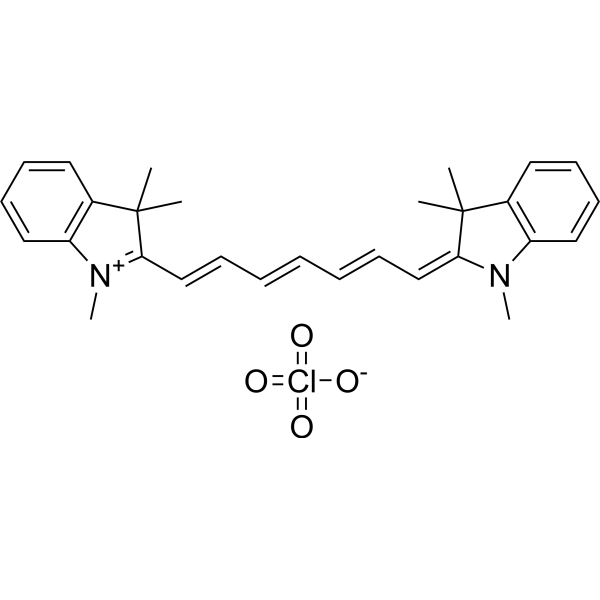
-
- HY-D1772
-
-
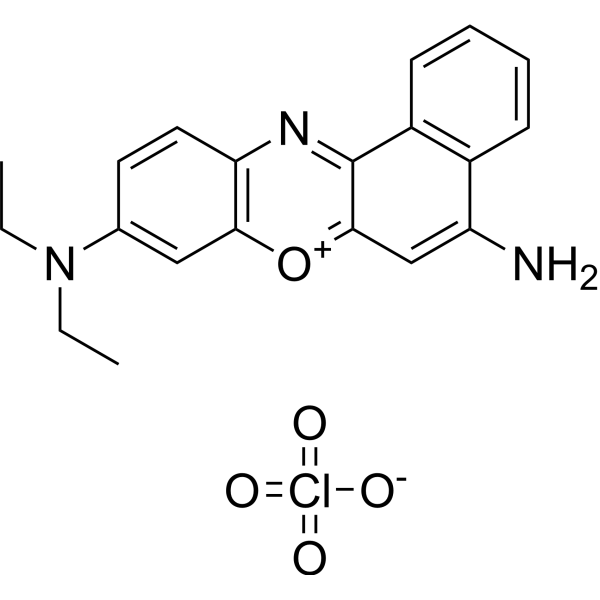
-
- HY-107641
-
|
α-Cyano-4-hydroxycinnamate
|
Monocarboxylate Transporter
|
Metabolic Disease
|
|
α-Cyano-4-hydroxycinnamic acid (α-Cyano-4-hydroxycinnamate) is a potent and non-competitive inhibitor of monocarboxylate transporters (MCTs). α-Cyano-4-hydroxycinnamic acid inhibits mitochondrial pyruvate transporter with a Ki of 6.3 μM. α-Cyano-4-hydroxycinnamic acid is used as a matrix to facilitate peptide ionization in matrix-assisted laser desorption/ionization time-of-flight (MALDI-TOF) mass spectrometry applications .
|
-
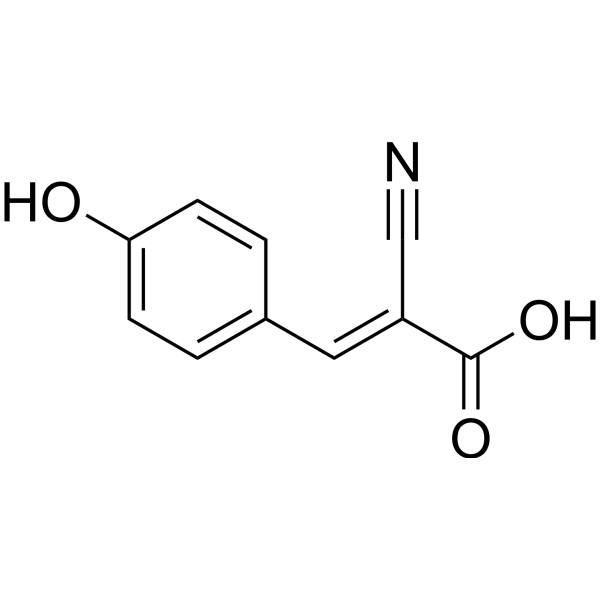
-
- HY-125750
-
-
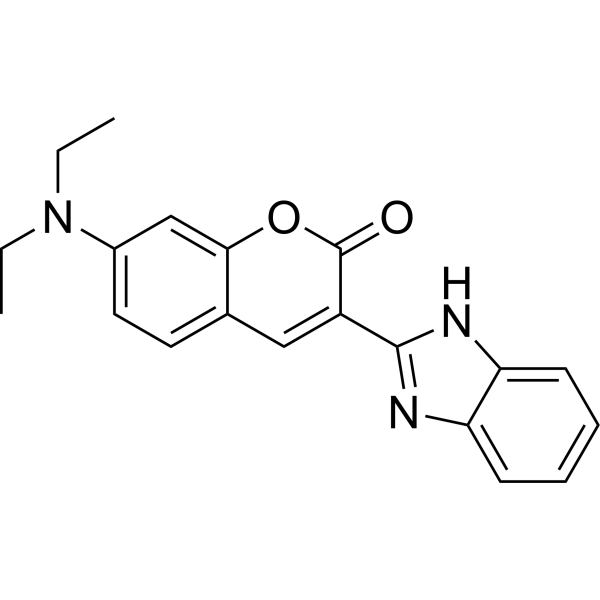
-
- HY-D0082
-
-
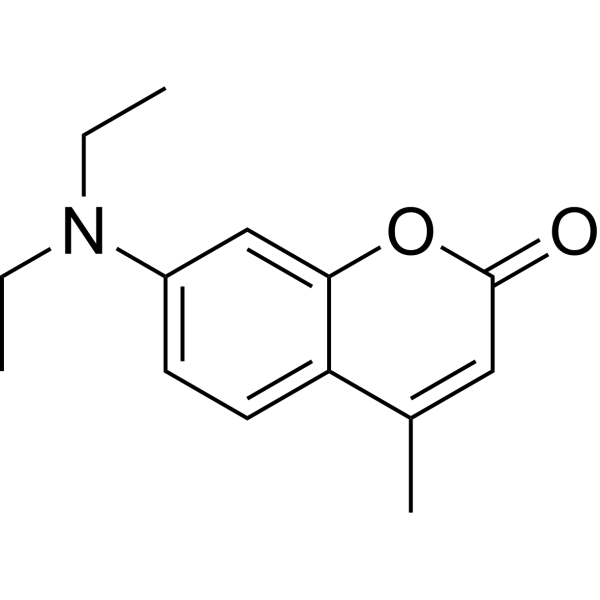
-
- HY-128793
-
|
(E)-Stilbene
|
Fluorescent Dye
|
Others
|
|
trans-Stilbene ((E)-Stilbene) is used in the manufacturing of dye lasers, optical brighteners, non-steroidal synthetic estrogens.
|
-
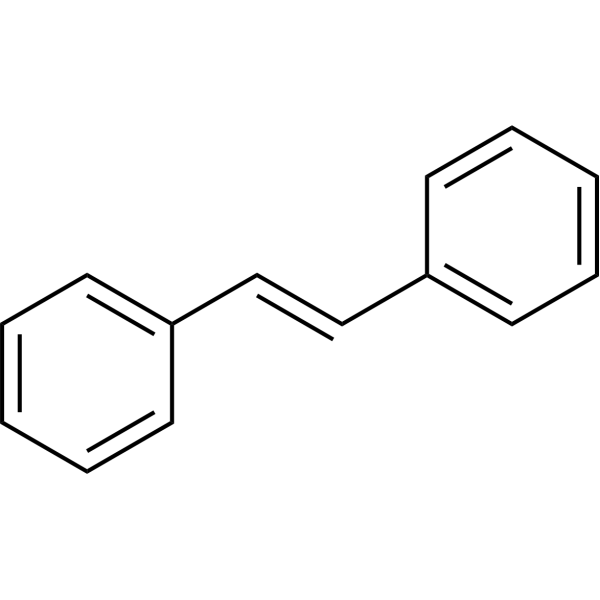
-
- HY-133534
-
|
|
Others
|
Others
|
|
PA-Nic TFA is a photoactivatable nicotine, whcih can be photolyzed with ~405 nm laser flashes to efficiently release nicotine .
|
-
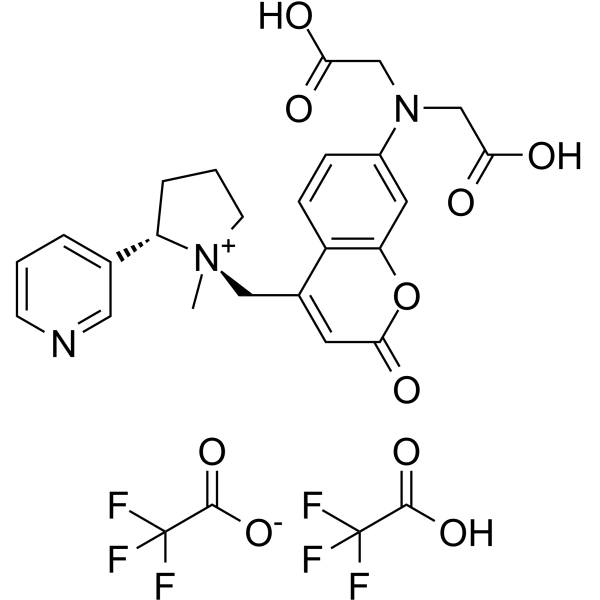
-
- HY-D0974
-
|
Acid Red 52; Kiton Red 620
|
Fluorescent Dye
|
Others
|
|
Sulforhodamine B sodium salt is a fluorescent dye with uses spanning from laser-induced fluorescence (LIF) to the quantification of cellular proteins of cultured cells.
|
-
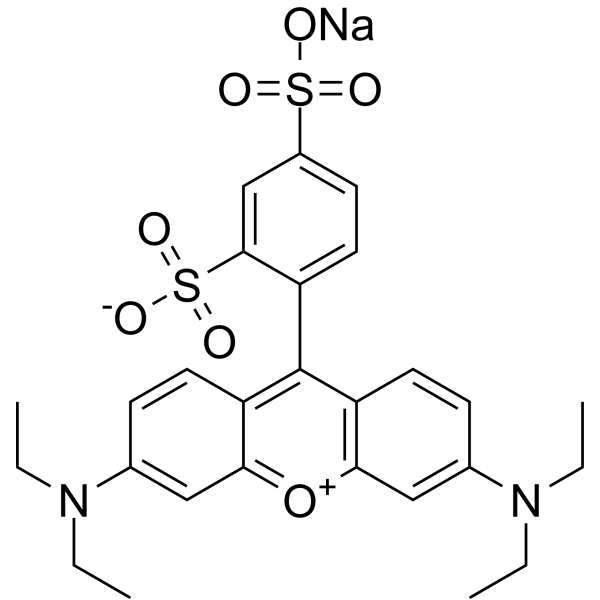
-
- HY-136946
-
|
|
Fluorescent Dye
|
Others
|
|
HITCI is a commercially available, positively charged indocarbocyanine dye. HITCI is used typically as a laser dye in the near infrared (NIR) .
|
-

-
- HY-126821
-
|
|
Fluorescent Dye
|
Others
|
|
Fluo-3 and related molecule Fluo3/AM are used as a fluorescence indicator of intracellular calcium (Ca 2+). Fluo-3 may be use for flow cytometry and confocal laser scanning microscopy using visible light excitation (compatible with argon laser sources operating at 488 nm). Fluorescence intensity increases about 40-fold after calcium binding.
|
-
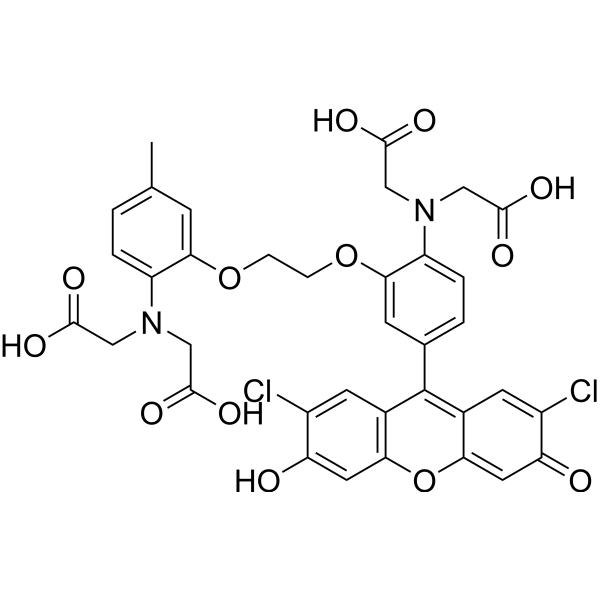
-
- HY-157317
-
|
|
Apoptosis
|
Cancer
|
|
Antitumor agent-126 (Compound II4) is a photoactive (IC50= 0.149) anticancer agent with significant near-infrared fluorescence emission at 650-760 nm. Antitumor agent-126 has antiproliferative activity and can induce apoptosis after laser irradiation. Antitumor agent-126 effectively inhibits tumor growth in mouse xenograft models exposed to 650 nm laser irradiation. Antitumor agent-126 can be used in cancer research .
|
-
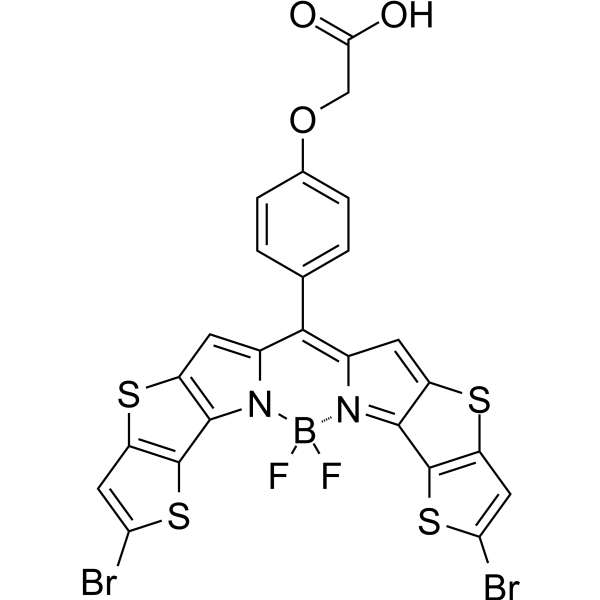
-
- HY-59021
-
|
|
Fluorescent Dye
|
Others
|
|
2-(4-Biphenylyl)-5-phenyl-1,3,4-oxadiazole is a laser dyes with high photoluminescence (PL) quantum efficiency .
|
-
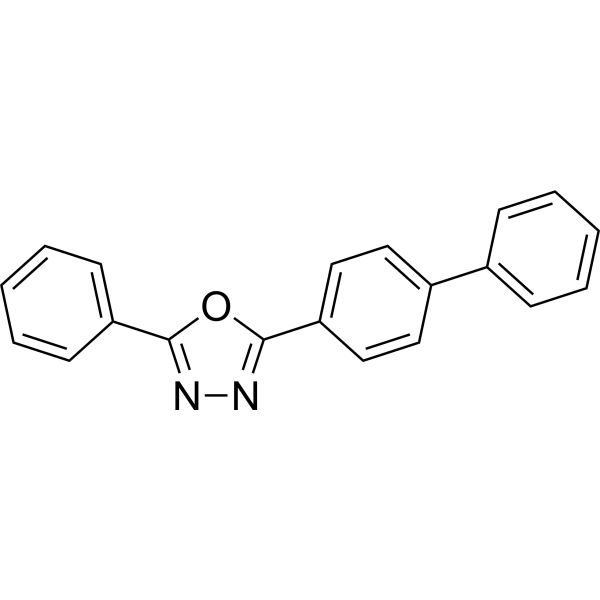
-
- HY-D1703
-
|
|
Fluorescent Dye
|
Others
|
|
Oxazine 170 perchlorate is a laser dye with a wide excitation spectrum range (300−550 nm), which strongly absorbs light with a wavelength greater than 550 nm, and it emits fluorescence with a wavelength of about 645 nm .
|
-
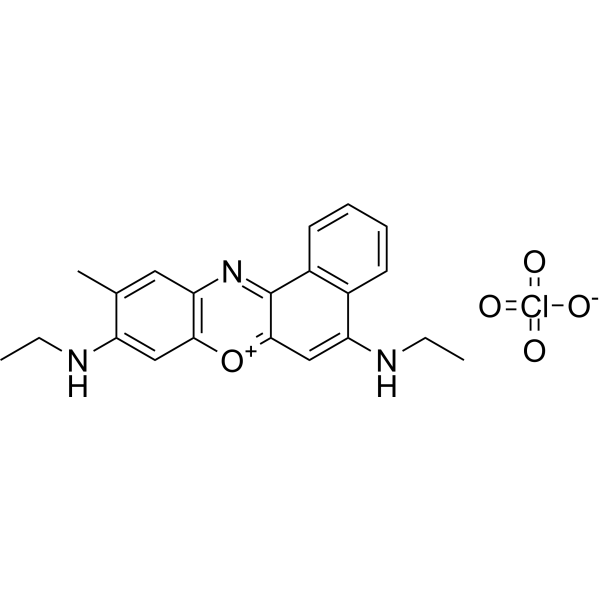
-
- HY-107689
-
|
|
Others
|
Neurological Disease
|
|
RuBiNic is a cage compound based on the photochemistry of Ru-bpy complexes and releases nicotine by irradiation with visible light up to 532 nm. RuBiNic is able to induce action potentials in Retzius neurons with 473 nm laser .
|
-
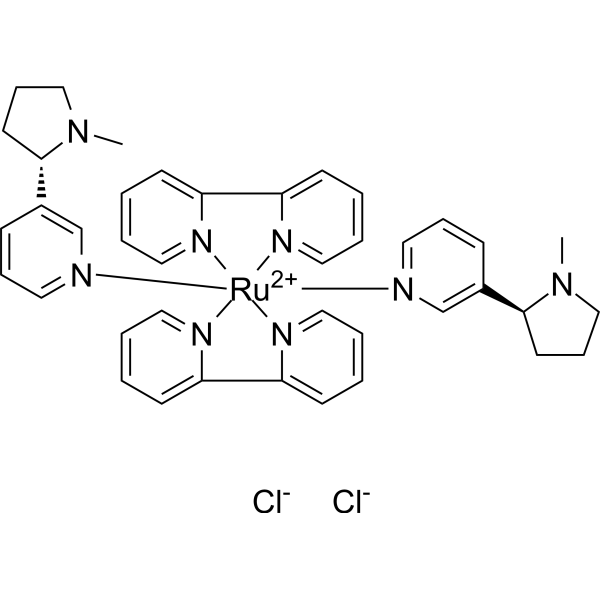
-
- HY-128793S1
-
|
(E)-Stilbene-d12
|
Isotope-Labeled Compounds
|
Others
|
|
trans-Stilbene-d12 is the deuterium labeled trans-Stilbene[1]. trans-Stilbene ((E)-Stilbene) is used in the manufacturing of dye lasers, optical brighteners, non-steroidal synthetic estrogens[2].
|
-
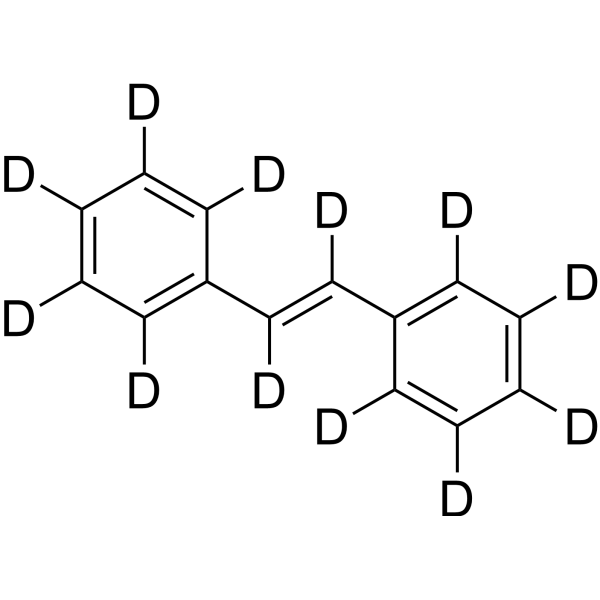
-
- HY-128793S2
-
|
(E)-Stilbene-d10
|
Isotope-Labeled Compounds
|
Others
|
|
trans-Stilbene-d10 is the deuterium labeled trans-Stilbene[1]. trans-Stilbene ((E)-Stilbene) is used in the manufacturing of dye lasers, optical brighteners, non-steroidal synthetic estrogens[2].
|
-
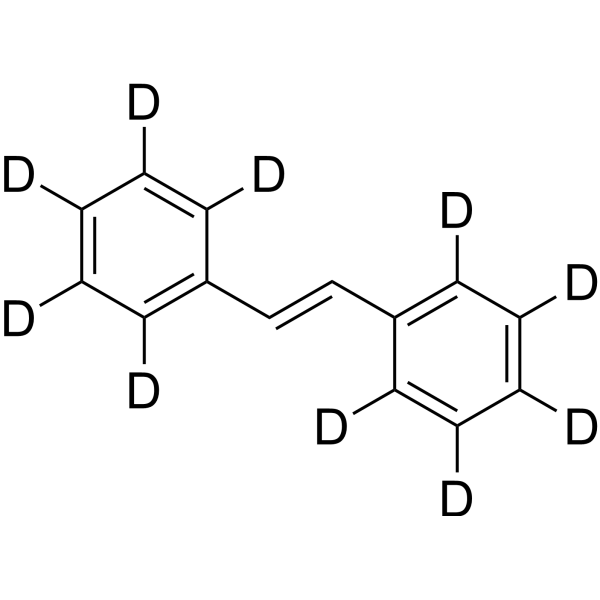
-
- HY-128793S3
-
|
(E)-Stilbene-d2
|
Isotope-Labeled Compounds
|
Others
|
|
trans-Stilbene-d2 is the deuterium labeled trans-Stilbene[1]. trans-Stilbene ((E)-Stilbene) is used in the manufacturing of dye lasers, optical brighteners, non-steroidal synthetic estrogens[2].
|
-
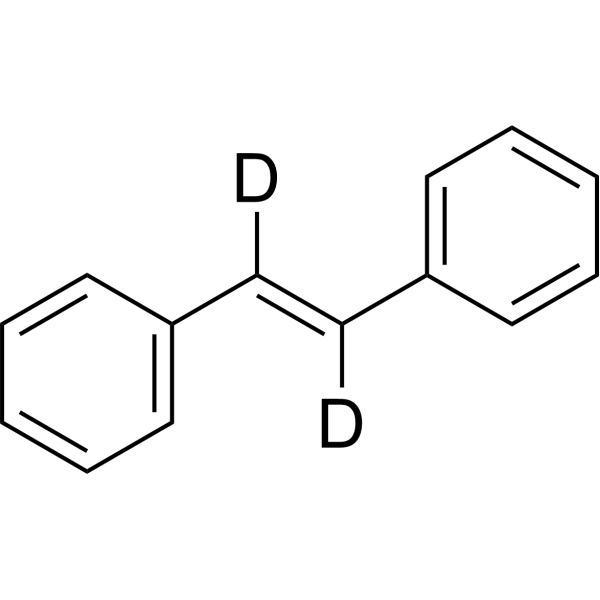
-
- HY-128793S
-
|
|
Isotope-Labeled Compounds
|
Others
|
|
trans-Stilbene- 13C2 is the 13C labeled trans-Stilbene[1]. trans-Stilbene ((E)-Stilbene) is used in the manufacturing of dye lasers, optical brighteners, non-steroidal synthetic estrogens[2].
|
-
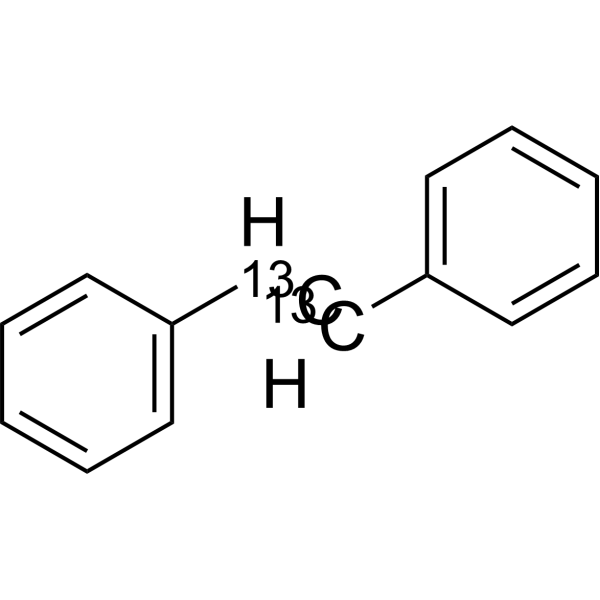
-
- HY-W088089
-
|
|
Fluorescent Dye
|
Others
|
|
ICG-carboxylic acid is near-infrared (NIR) fluorescent probe. ICG is a fluorescent dye used in medical diagnostics. ICG has absorption peaking at 800 nm and can absorb the near IR laser energy and release heat in the dyed tissue .
|
-

-
- HY-150743B
-
|
|
Toll-like Receptor (TLR)
|
Inflammation/Immunology
|
|
FITC-labeled ODN 2395 (sodium), a C class oligodeoxynucleotide, is a TLR9 agonist. FITC-labeled ODN 2395 (sodium) can be used to evaluate CpG ODN cellular uptake and localization by confocal laser-scanning microscopy (excitation 495 nm, emission 520 nm) or flow cytometry.
|
-
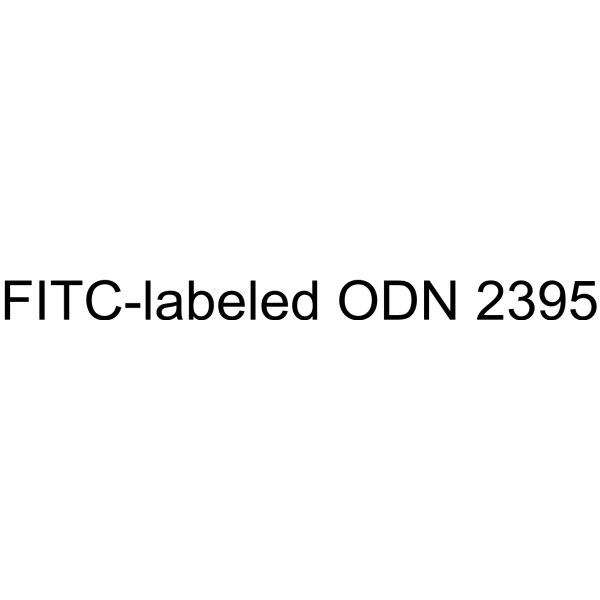
-
- HY-150725B
-
|
|
Toll-like Receptor (TLR)
|
Inflammation/Immunology
|
|
FITC-labeled ODN 1585 (sodium) is a potent inducer of IFN and TNFα production. FITC-labeled ODN 1585 (sodium) can be used to evaluate CpG ODN cellular uptake and localization by confocal laser-scanning microscopy (excitation 495 nm, emission 520 nm) or flow cytometry.
|
-

-
- HY-150724B
-
|
|
Toll-like Receptor (TLR)
|
Inflammation/Immunology
|
|
FITC-labeled ODN 1018 (sodium),an oligodeoxynucleotide, is a TLR-9 agonist. FITC-labeled ODN 1018 (sodium) can be used to evaluate CpG ODN cellular uptake and localization by confocal laser-scanning microscopy (excitation 495 nm, emission 520 nm) or flow cytometry.
|
-
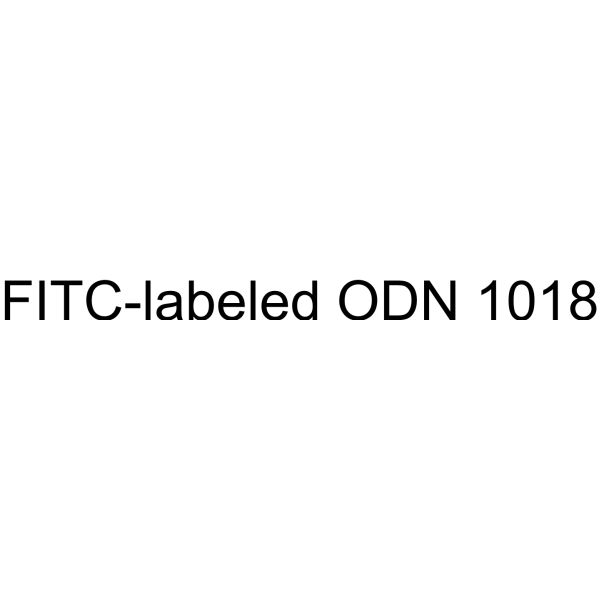
-
- HY-146244B
-
|
|
Toll-like Receptor (TLR)
|
Inflammation/Immunology
|
|
FITC-labeled Agatolimod (sodium), a class B CpG ODN (oligodeoxynucleotide), is a TLR9 agonist. FITC-labeled Agatolimod (sodium) can be used to evaluate CpG ODN cellular uptake and localization by confocal laser-scanning microscopy (excitation 495 nm, emission 520 nm) or flow cytometry.
|
-
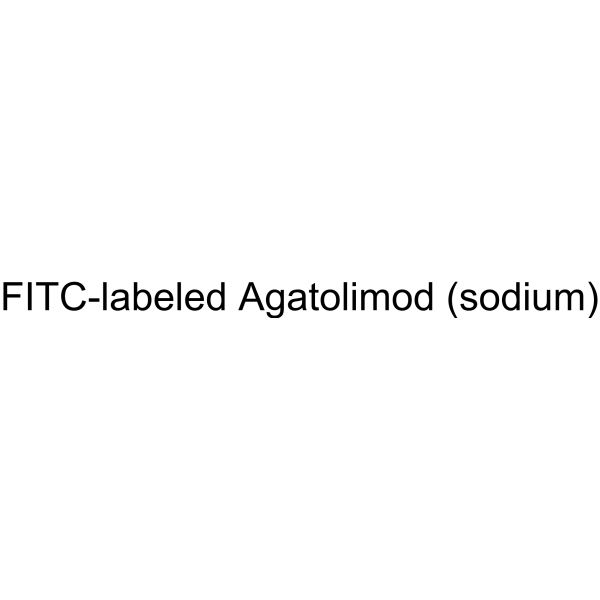
-
- HY-W127721
-
|
Phthalocyanine tetrasulfonic acid
|
Biochemical Assay Reagents
|
Others
|
|
Tetrasulfophthalocyanine is an organic compound commonly used as dyes, photosensitive materials and catalysts. It can be used in certain organic batteries, solar cells, and laser printing, and is widely used in chemical analysis, biotechnology, and environmental monitoring. In addition, this compound is also used as a substrate or catalyst in certain biochemical reactions.
|
-

-
- HY-150738B
-
|
|
Toll-like Receptor (TLR)
|
Inflammation/Immunology
|
|
FITC-labeled ODN 2088 (sodium) is a potent TLR3, TLR7 and TLR9 inhibitor. FITC-labeled ODN 2088 (sodium) can be used to evaluate CpG ODN cellular uptake and localization by confocal laser-scanning microscopy (excitation 495 nm, emission 520 nm) or flow cytometry.
|
-
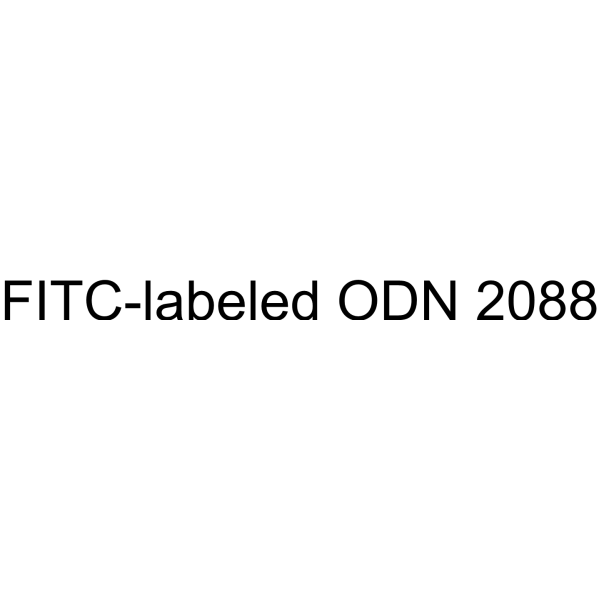
-
- HY-150726B
-
|
|
Toll-like Receptor (TLR)
|
Inflammation/Immunology
|
|
FITC-labeled ODN 1668 (sodium), a class B CpG ODN (oligodeoxynucleotide), is a TLR9 agonist. FITC-labeled ODN 1668 (sodium) can be used to evaluate CpG ODN cellular uptake and localization by confocal laser-scanning microscopy (excitation 495 nm, emission 520 nm) or flow cytometry.
|
-

-
- HY-146245B
-
|
|
Toll-like Receptor (TLR)
|
Inflammation/Immunology
|
|
FITC-labeled ODN 1826 (sodium), a class B CpG ODN (oligodeoxynucleotide), is a TLR9 agonist. FITC-labeled ODN 1826 (sodium) can be used to evaluate CpG ODN cellular uptake and localization by confocal laser-scanning microscopy (excitation 495 nm, emission 520 nm) or flow cytometry.
|
-

-
- HY-150751B
-
|
|
Toll-like Receptor (TLR)
|
Inflammation/Immunology
|
|
FITC-labeled ODN TTAGGG (sodium), a inhibitory oligonucleotide (ODN), is a TLR9, AIM2 and cGAS antagonist. FITC-labeled ODN TTAGGG (sodium) can be used to evaluate CpG ODN cellular uptake and localization by confocal laser-scanning microscopy (excitation 495 nm, emission 520 nm) or flow cytometry.
|
-

-
- HY-B1157
-
|
Trisoralen; Trioxysalen; TMP
|
DNA Alkylator/Crosslinker
|
Inflammation/Immunology
|
|
Trioxsalen (Trisoralen), a psoralen derivative, is a photochemical DNA crosslinker. Trioxsalen only works after photoactivation with near ultraviolet light. Trioxsalen is a photosensitizer that can be used for the research of vitiligo and hand eczema. Trioxsalen is used for visualization of genomic interstrand cross-links localized by laser photoactivation .
|
-
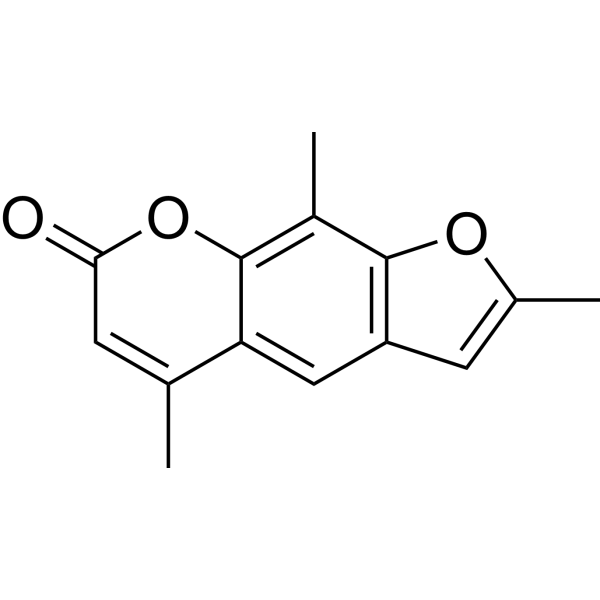
-
- HY-150741B
-
|
|
Toll-like Receptor (TLR)
Interleukin Related
|
Inflammation/Immunology
|
|
FITC-labeled ODN 2216 (sodium) is a human-specific TLR9 (toll-like receptor 9) ligand or agonist. FITC-labeled ODN 2216 (sodium) can be used to evaluate CpG ODN cellular uptake and localization by confocal laser-scanning microscopy (excitation 495 nm, emission 520 nm) or flow cytometry.
|
-
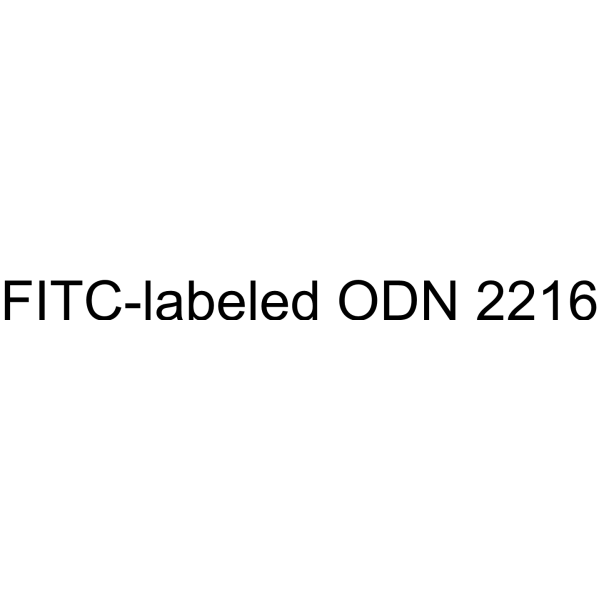
-
- HY-147521
-
|
|
Necroptosis
|
Cancer
|
|
Antitumor photosensitizer-3 (Compound I) is a chlorin derivative. Antitumor photosensitizer-3 induces tumor cells apoptosis and necrosis under 650 nm laser irradiation. Antitumor photosensitizer-3 exhibits lower skin photo-toxicity than positive reference m-THPC in vivo .
|
-
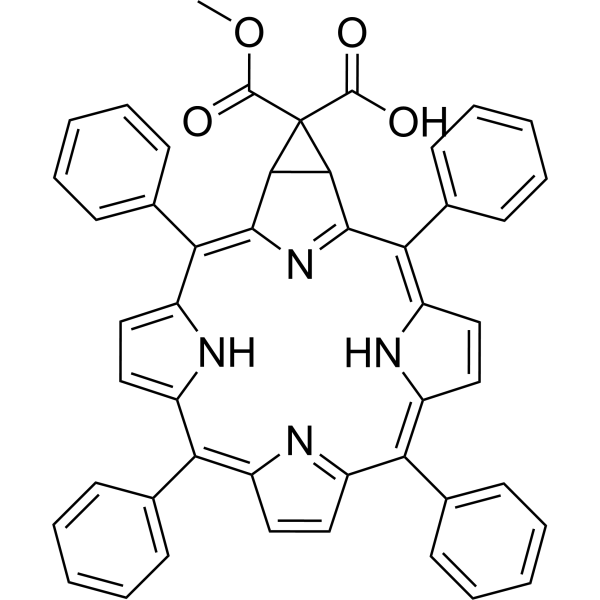
-
- HY-D1905
-
|
|
Fluorescent Dye
|
Cancer
|
|
ICG acid is a fluorescent dye used in medical diagnostics. ICG acid has absorption peaking at 800 nm and can absorb the near IR laser energy and release heat in the dyed tissue. ICG acid has been used in fluorescence-guided surgery to identify critical structures, including intra-abdominal tumors .
|
-
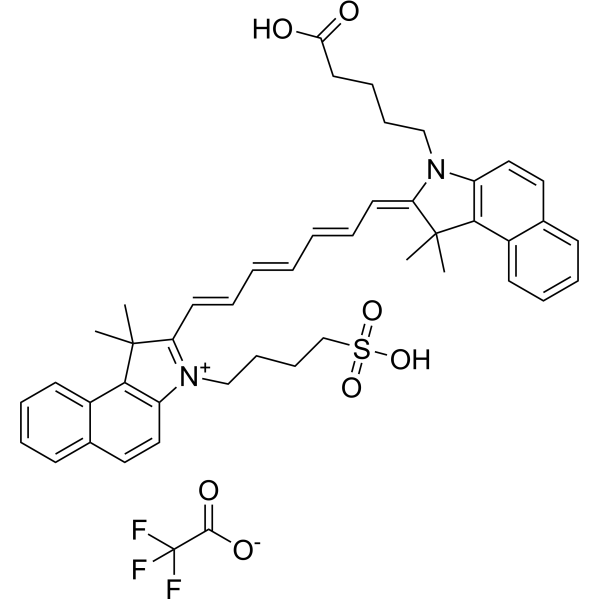
-
- HY-Y0293
-
|
L-(+)-Tartaric acid
|
|
|
|
L-tartaric acid (L-(+) -tartaric acid) is an orally active weak organic acid that can be isolated from grapes. L-Tartaric acid has vasodilatory and antihypertensive effects. L-Tartaric acid can be used as flavorings and antioxidants in a range of foods and beverages. L-Tartaric acid can be used in laser frequency doubling and optical limiting applications .
|
-
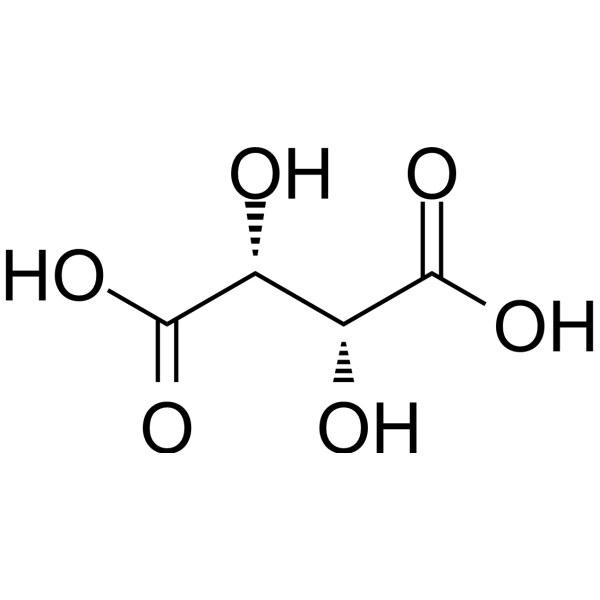
-
- HY-D2012
-
|
|
Fluorescent Dye
|
Others
|
|
ATTO 488 iodacetamid is a fluorescent dye suitable for single molecule detection applications and high-resolution microscopy for use in flow cytometry (FACS), fluorescence in situ hybridization (FISH) experiments. ATTO 488 iodacetamid has an effective excitation wavelength of 480-515 nm. When using an argon ion laser, the excitation wavelength is recommended to be 488 nm.
|
-
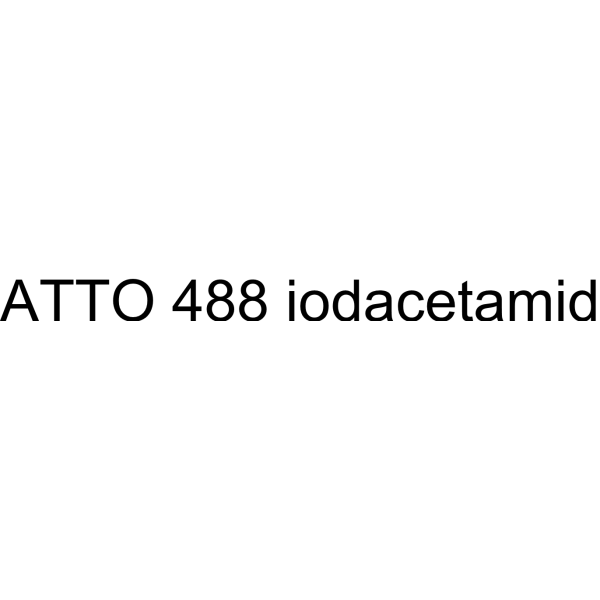
-
- HY-108708
-
|
|
PARP
|
Cancer
|
|
GeA-69 is a selective, allosteric inhibitor of poly-adenosine-diphosphate-ribose polymerase 14 (PARP14) targeting macrodomain 2 (MD2), with a Kd value of 2.1 µM. GeA-69 involves in DNA damage repair mechanisms and prevents recruitment of PARP14 MD2 to sites of laser-induced DNA damage .
|
-
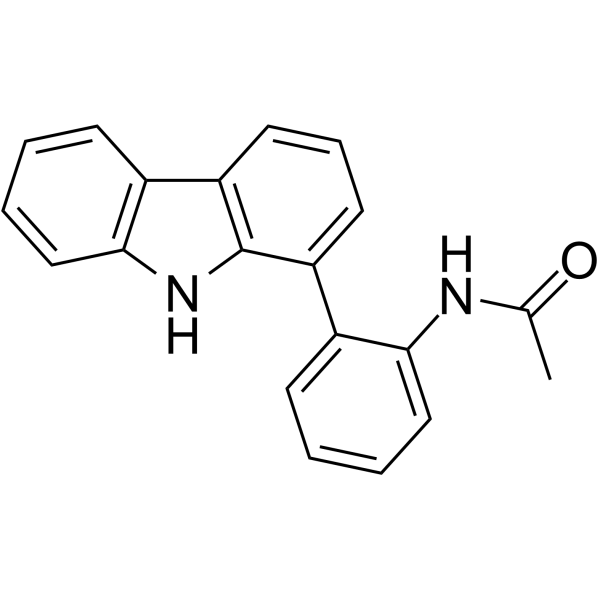
-
- HY-W110772
-
|
Coumarin 540A
|
Others
|
Others
|
|
Coumarin153 is a coumarin. Coumarin153 can used as a fluorescence probe of Na dodecyl sulfate and cetyltrimethylammonium bromide .
|
-

-
- HY-D0090
-
|
|
Fluorescent Dye
|
Others
|
|
MQAE is a fluorescently-labeled deoxyglucose analog that is used primarily to directly monitor glucose uptake by living cells and tissues. It is also used as a topical contrast reagent for the detection of neoplasia. MQAE can be used in real-time confocal, high-resolution, or wide-field fluorescence microscopy as well as in flow cytometry. The probe can be excited by the Argon laser at 488 nm to give the environment-sensitive fluorescence. It has lower photostability than the rhodamine-based fluorescent probes.
|
-
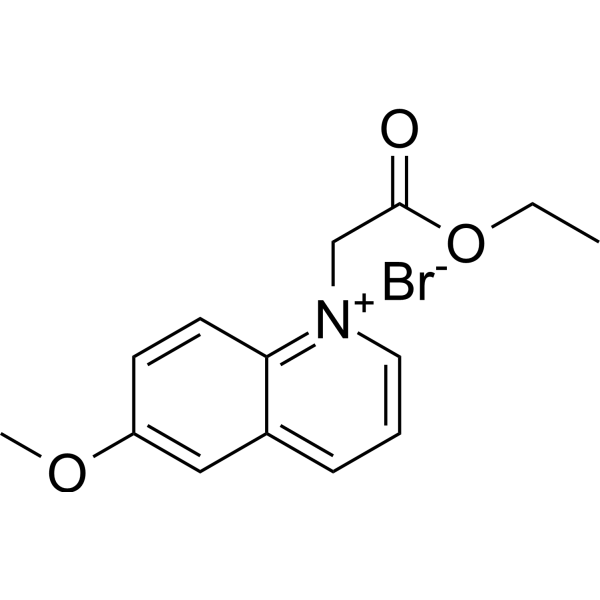
-
- HY-D0333
-
|
Sirius Red
|
Amyloid-β
|
Others
|
|
Direct Red 80 (Sirius Red) is a polyazo dye used principally in staining methods for collagen and amyloid. Direct Red 80 does not release benzidine upon degradation and is safer than many traditional direct dyes .
|
-

- HY-116215
-
2-NBDG
Maximum Cited Publications
27 Publications Verification
|
Fluorescent Dye
|
Others
|
|
2-NBDG is a fluorescently-labeled deoxyglucose analog that is used primarily to directly monitor glucose uptake by living cells and tissues. It is also used as a topical contrast reagent for the detection of neoplasia. 2-NBDG can be used in real-time confocal, high-resolution, or wide-field fluorescence microscopy as well as in flow cytometry. The probe can be excited by the Argon laser at 488 nm to give the environment-sensitive fluorescence. It has lower photostability than the rhodamine-based fluorescent probes.
|
-

- HY-D1482
-
|
|
Fluorescent Dye
|
Others
|
|
Cy5 Tetrazine is a water-soluble, pH-insensitive from pH 4 to pH 10, far-red-fluorescent probe with excitation ideally suited for the 633 nm or 647 nm laser lines. Its absorption and emission spactra are almost identical to those of Alexa Fluor 647, CF 647 Dye, or any other Cyanine5 based fluorescent dyes. Sulfo-Cy5-tetrazine is a click chemistry reagent, it contains a Tetrazine group that can undergo an inverse electron demand Diels-Alder reaction (iEDDA) with molecules containing TCO groups.
|
-

- HY-D1459
-
|
|
Fluorescent Dye
|
Metabolic Disease
|
|
BODIPY 665/676 is a lipophilic radical-sensitive fluorescent probe that can be used to study radical-driven lipid autoxidation .
|
-
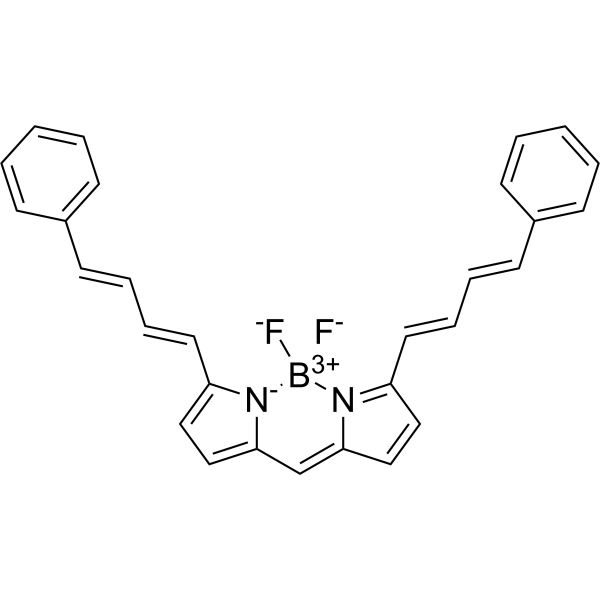
- HY-D1074
-
|
3,3'-Dipropyloxacarbocyanine iodide
|
Fluorescent Dye
|
Others
|
|
DiOC3(3) (3,3'-Dipropyloxacarbocyanine iodide) is a green fluorescent lipophilic dye with cell membrane permeability. DiOC3(3) can be used to stain cell membranes and other lipid-soluble biological structures .
|
-
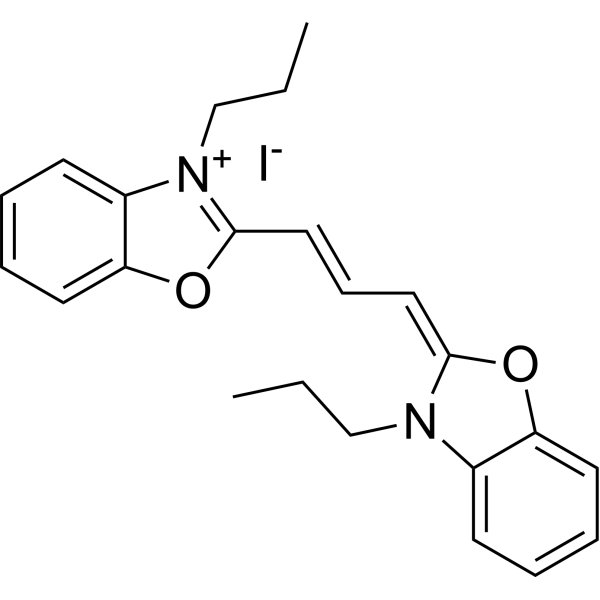
| Cat. No. |
Product Name |
Type |
-
- HY-121930
-
-
- HY-W248115
-
|
|
Fluorescent Dyes/Probes
|
|
Pyrromethene 597 is a BODIPY laser dye. Pyrromethene 597 displays wide tuning range of lasing wavelengths and high photostability. Pyrromethene 597 can be used as a thermal probe .
|
-
- HY-136886
-
IR-820
1 Publications Verification
New Indocyanine Green
|
Fluorescent Dyes/Probes
|
|
IR-820 (New Indocyanine Green) is an infrared blood pool contrast agent. IR-820 also is normally used as a laser and near-infrared dye to detect and quantify diseased tissue in live animals .
|
-
- HY-D0027
-
|
Coumarin 120; AMC
|
Fluorescent Dyes/Probes
|
|
7-Amino-4-methylcoumarin belongs to a group of coumarins. 7-Amino-4-methylcoumarin can be isolated from an endophytic fungus Xylaria sp., has broad antimicrobial activity. 7-Amino-4-methylcoumarin is additionally commonly used as an important laser dye emitting in the blue region, as well as a fluorescent probe enabling analyses of glycoproteins’ monosaccharides and N-linked oligosaccharides. The excitation wavelength and emission wavelength are 351 nm and 430 nm, respectively .
|
-
- HY-W267393
-
|
|
Dyes
|
|
4,6-Dimethyl-7-ethylaminocoumarin is a laser dye for pulse and continuous operation .
|
-
- HY-D1762
-
-
- HY-D1747
-
-
- HY-W440303
-
|
HITC
|
Fluorescent Dyes/Probes
|
|
1,1',3,3,3',3'-Hexamethylindotricarbocyanine perchlorate (HITC) is a long-wavelength, membrane-potential sensitive dye. It is a slow-response potentiometric fluorophore and has also been used as a laser dye for infrared lasers.
|
-
- HY-D1772
-
-
- HY-125750
-
|
|
Protein Labeling
|
|
Coumarin 7 is a coumarin laser dye in plants in the form of glycosides .
|
-
- HY-D0082
-
-
- HY-D0974
-
|
Acid Red 52; Kiton Red 620
|
Dyes
|
|
Sulforhodamine B sodium salt is a fluorescent dye with uses spanning from laser-induced fluorescence (LIF) to the quantification of cellular proteins of cultured cells.
|
-
- HY-126821
-
|
|
Fluorescent Dyes/Probes
|
|
Fluo-3 and related molecule Fluo3/AM are used as a fluorescence indicator of intracellular calcium (Ca 2+). Fluo-3 may be use for flow cytometry and confocal laser scanning microscopy using visible light excitation (compatible with argon laser sources operating at 488 nm). Fluorescence intensity increases about 40-fold after calcium binding.
|
-
- HY-59021
-
|
|
Fluorescent Dyes/Probes
|
|
2-(4-Biphenylyl)-5-phenyl-1,3,4-oxadiazole is a laser dyes with high photoluminescence (PL) quantum efficiency .
|
-
- HY-D1703
-
|
|
Fluorescent Dyes/Probes
|
|
Oxazine 170 perchlorate is a laser dye with a wide excitation spectrum range (300−550 nm), which strongly absorbs light with a wavelength greater than 550 nm, and it emits fluorescence with a wavelength of about 645 nm .
|
-
- HY-W088089
-
|
|
Fluorescent Dyes/Probes
|
|
ICG-carboxylic acid is near-infrared (NIR) fluorescent probe. ICG is a fluorescent dye used in medical diagnostics. ICG has absorption peaking at 800 nm and can absorb the near IR laser energy and release heat in the dyed tissue .
|
-
- HY-W127721
-
|
Phthalocyanine tetrasulfonic acid
|
Dyes
|
|
Tetrasulfophthalocyanine is an organic compound commonly used as dyes, photosensitive materials and catalysts. It can be used in certain organic batteries, solar cells, and laser printing, and is widely used in chemical analysis, biotechnology, and environmental monitoring. In addition, this compound is also used as a substrate or catalyst in certain biochemical reactions.
|
-
- HY-D1905
-
|
|
Fluorescent Dyes/Probes
|
|
ICG acid is a fluorescent dye used in medical diagnostics. ICG acid has absorption peaking at 800 nm and can absorb the near IR laser energy and release heat in the dyed tissue. ICG acid has been used in fluorescence-guided surgery to identify critical structures, including intra-abdominal tumors .
|
-
- HY-D2012
-
|
|
Fluorescent Dyes/Probes
|
|
ATTO 488 iodacetamid is a fluorescent dye suitable for single molecule detection applications and high-resolution microscopy for use in flow cytometry (FACS), fluorescence in situ hybridization (FISH) experiments. ATTO 488 iodacetamid has an effective excitation wavelength of 480-515 nm. When using an argon ion laser, the excitation wavelength is recommended to be 488 nm.
|
-
- HY-D0090
-
|
|
Fluorescent Dyes/Probes
|
|
MQAE is a fluorescently-labeled deoxyglucose analog that is used primarily to directly monitor glucose uptake by living cells and tissues. It is also used as a topical contrast reagent for the detection of neoplasia. MQAE can be used in real-time confocal, high-resolution, or wide-field fluorescence microscopy as well as in flow cytometry. The probe can be excited by the Argon laser at 488 nm to give the environment-sensitive fluorescence. It has lower photostability than the rhodamine-based fluorescent probes.
|
-
- HY-116215
-
2-NBDG
Maximum Cited Publications
27 Publications Verification
|
Fluorescent Dyes/Probes
|
|
2-NBDG is a fluorescently-labeled deoxyglucose analog that is used primarily to directly monitor glucose uptake by living cells and tissues. It is also used as a topical contrast reagent for the detection of neoplasia. 2-NBDG can be used in real-time confocal, high-resolution, or wide-field fluorescence microscopy as well as in flow cytometry. The probe can be excited by the Argon laser at 488 nm to give the environment-sensitive fluorescence. It has lower photostability than the rhodamine-based fluorescent probes.
|
-
- HY-D1482
-
|
|
Fluorescent Dyes/Probes
|
|
Cy5 Tetrazine is a water-soluble, pH-insensitive from pH 4 to pH 10, far-red-fluorescent probe with excitation ideally suited for the 633 nm or 647 nm laser lines. Its absorption and emission spactra are almost identical to those of Alexa Fluor 647, CF 647 Dye, or any other Cyanine5 based fluorescent dyes. Sulfo-Cy5-tetrazine is a click chemistry reagent, it contains a Tetrazine group that can undergo an inverse electron demand Diels-Alder reaction (iEDDA) with molecules containing TCO groups.
|
-
- HY-D1459
-
|
|
Fluorescent Dyes/Probes
|
|
BODIPY 665/676 is a lipophilic radical-sensitive fluorescent probe that can be used to study radical-driven lipid autoxidation .
|
-
- HY-D1074
-
|
3,3'-Dipropyloxacarbocyanine iodide
|
Fluorescent Dyes/Probes
|
|
DiOC3(3) (3,3'-Dipropyloxacarbocyanine iodide) is a green fluorescent lipophilic dye with cell membrane permeability. DiOC3(3) can be used to stain cell membranes and other lipid-soluble biological structures .
|
| Cat. No. |
Product Name |
Type |
-
- HY-D0850
-
|
Sodium tartrate dibasic dihydrate; Sodium tartrate dihydrate
|
Biochemical Assay Reagents
|
|
Tartaric acid disodium dehydrate (L-(+) -tartaric acid) is an orally active weak organic acid that can be isolated from grapes. Tartaric acid disodium dehydrate has vasodilatory and antihypertensive effects. Tartaric acid disodium dehydrate can be used as flavorings and antioxidants in a range of foods and beverages. Tartaric acid disodium dehydrate can be used in laser frequency doubling and optical limiting applications .
|
-
- HY-W109973
-
|
L-(+)-Tartaric acid diammonium
|
Biochemical Assay Reagents
|
|
L-Tartaric acid diammonium (L-(+) -tartaric acid) is an orally active weak organic acid that can be isolated from grapes. L-Tartaric acid diammonium has vasodilatory and antihypertensive effects. L-Tartaric acid diammonium can be used as flavorings and antioxidants in a range of foods and beverages. L-Tartaric acid diammonium can be used in laser frequency doubling and optical limiting applications .
|
-
- HY-Y0030A
-
|
3-HPA
|
Biochemical Assay Reagents
|
|
3-Hydroxypicolinic acid, matrix substance for MALDI-MS is a matrix material used in matrix-assisted laser desorption/ionization (MALDI) based mass spectroscopy (MS) for the analysis of large biomolecules and quantification of oligonucleotides. .
|
| Cat. No. |
Product Name |
Category |
Target |
Chemical Structure |
| Cat. No. |
Product Name |
Chemical Structure |
-
- HY-128793S1
-
|
|
|
trans-Stilbene-d12 is the deuterium labeled trans-Stilbene[1]. trans-Stilbene ((E)-Stilbene) is used in the manufacturing of dye lasers, optical brighteners, non-steroidal synthetic estrogens[2].
|
-

-
- HY-128793S2
-
|
|
|
trans-Stilbene-d10 is the deuterium labeled trans-Stilbene[1]. trans-Stilbene ((E)-Stilbene) is used in the manufacturing of dye lasers, optical brighteners, non-steroidal synthetic estrogens[2].
|
-

-
- HY-128793S3
-
|
|
|
trans-Stilbene-d2 is the deuterium labeled trans-Stilbene[1]. trans-Stilbene ((E)-Stilbene) is used in the manufacturing of dye lasers, optical brighteners, non-steroidal synthetic estrogens[2].
|
-

-
- HY-128793S
-
|
|
|
trans-Stilbene- 13C2 is the 13C labeled trans-Stilbene[1]. trans-Stilbene ((E)-Stilbene) is used in the manufacturing of dye lasers, optical brighteners, non-steroidal synthetic estrogens[2].
|
-

| Cat. No. |
Product Name |
|
Classification |
-
- HY-D1482
-
|
|
|
Tetrazine
Labeling and Fluorescence Imaging
|
|
Cy5 Tetrazine is a water-soluble, pH-insensitive from pH 4 to pH 10, far-red-fluorescent probe with excitation ideally suited for the 633 nm or 647 nm laser lines. Its absorption and emission spactra are almost identical to those of Alexa Fluor 647, CF 647 Dye, or any other Cyanine5 based fluorescent dyes. Sulfo-Cy5-tetrazine is a click chemistry reagent, it contains a Tetrazine group that can undergo an inverse electron demand Diels-Alder reaction (iEDDA) with molecules containing TCO groups.
|
Your information is safe with us. * Required Fields.
Inquiry Information
- Product Name:
- Cat. No.:
- Quantity:
- MCE Japan Authorized Agent:






























































